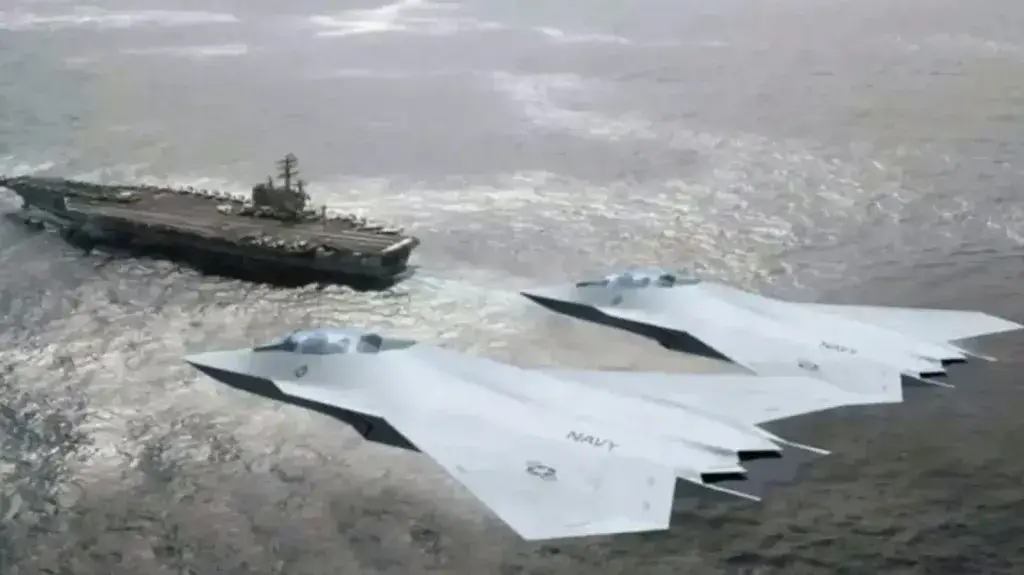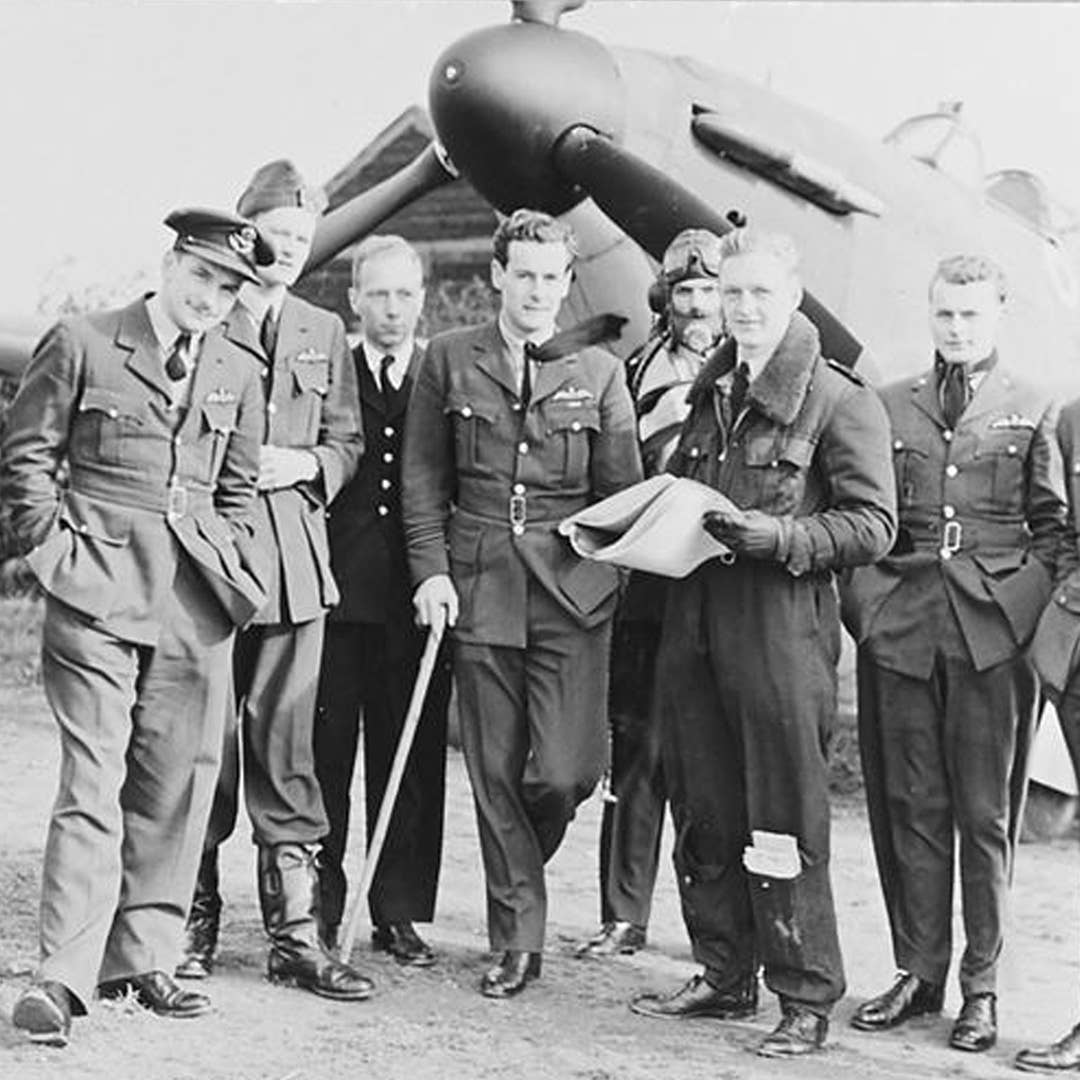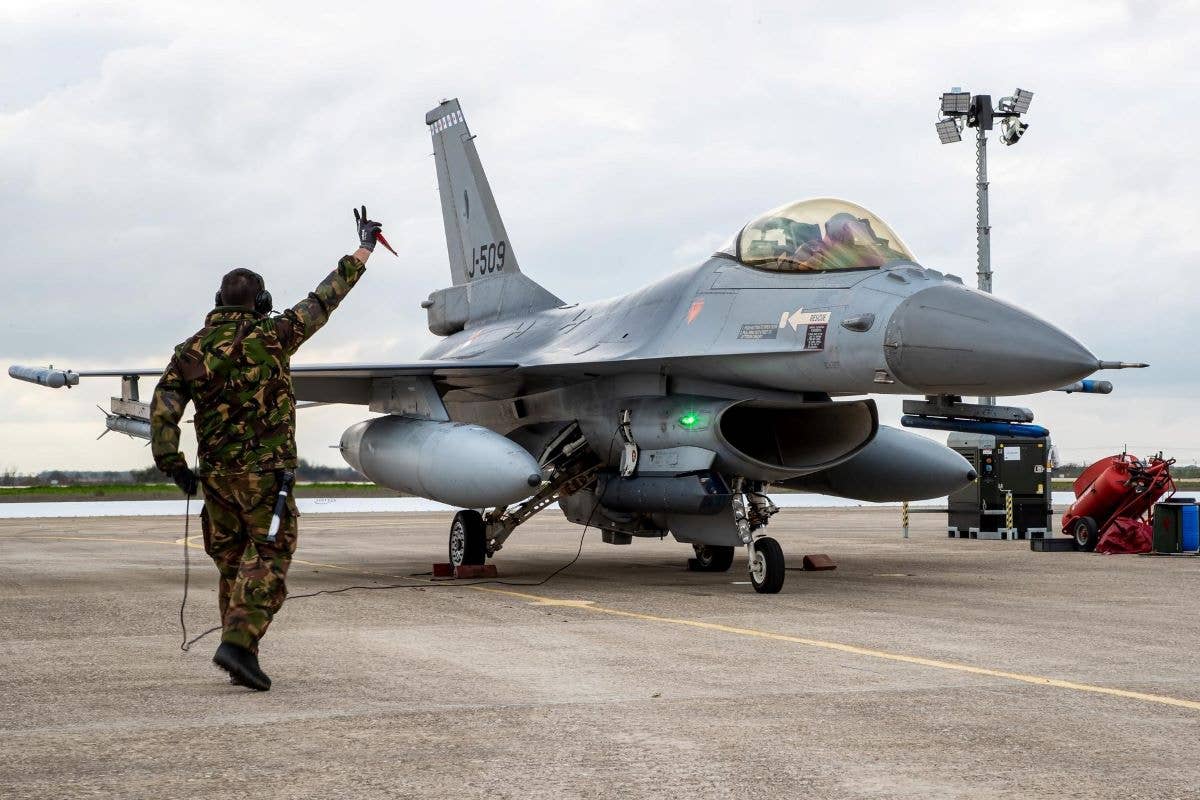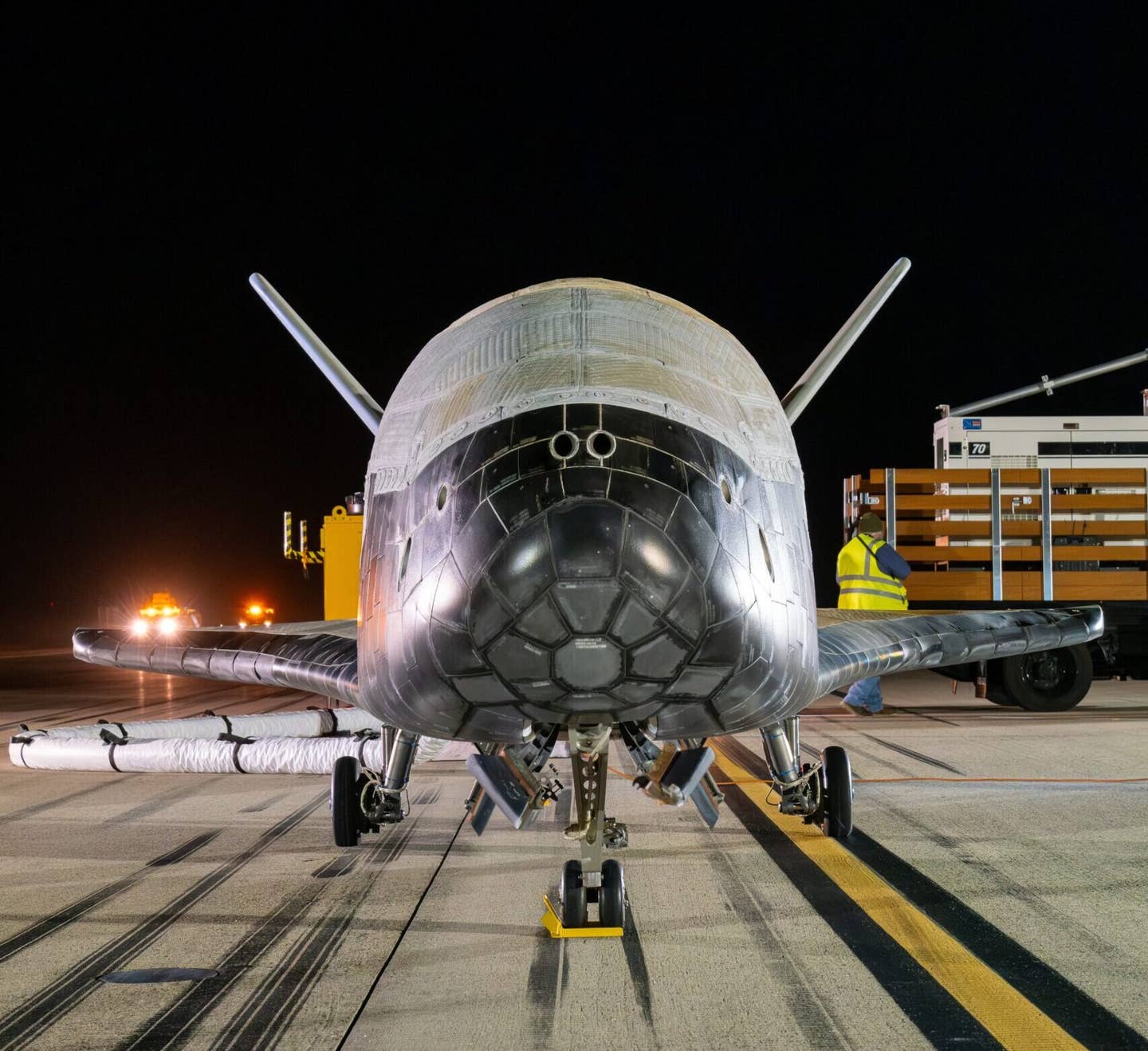A Recovery Mission Continues—Nearly Seven Decades Later
In 1952, a C-124 flew straight into a remote Alaskan mountain top, killing all aboard. Here’s the story of what it’s taking to bring them home.
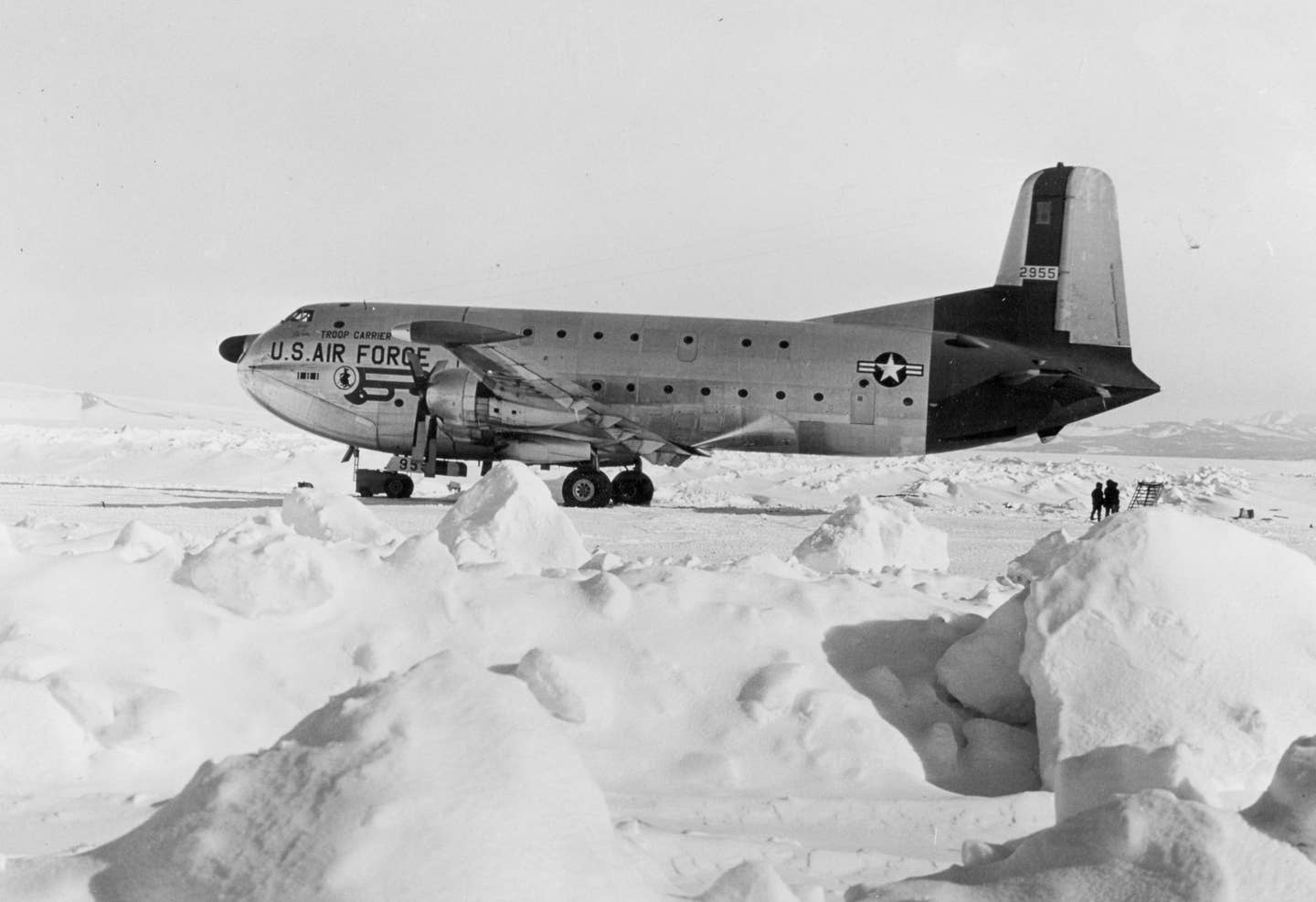
In the 1950s, the C-124 was the largest cargo aircraft the U.S. had in its arsenal. Courtesy: National Museum of the U.S. Air Force
On the afternoon of November 22, 1952, and while sitting at McChord Air Force Base in Tacoma, Washington, awaiting a transport flight to his next duty station, Airman Isaac Anderson took advantage of what time he had left. He pulled out paper to write a letter home to his wife, Dorothy, who was more than 3,000 miles away at their home in Tampa, Florida.
The 22-year-old had been in the service for less than two years, joining the U.S. Air Force as the service began desegregation. He was motivated to enlist in order to provide a better life for his wife and their son—his namesake—who was celebrating his second birthday in two months.
“Am now looking to leave here within the next two hours,” Anderson scrawled in blue pen. “Going back to Alaska. All I want you to do is write me every day and stay sweet.”
Printed across the top of the page above his words was “United States Air Force,” alongside a seal, and two fighter prop warbirds emerging from a cloud.
Anderson finished up, and posted the letter before climbing aboard the C-124A Globemaster II with tail number 1107, set to depart at 3:30 p.m., en route to Elmendorf Air Force Base in Anchorage. The aircraft was assigned to the 1705th Air Transport Group, 34th Air Transport Squadron, based at McChord Air Force Base, and it had been in service for seven months, having spent about 500 hours in the sky.
As far as military flights go, the journey was routine. Onboard were eight soldiers, a Navy commander, a Marine Corps major, and 41 airmen, 11 of whom were crew. The airplane was fully loaded, with a gross weight of 174,746 pounds, just 254 pounds shy of the maximum weight allowed. At least 3,000 pounds of the contents in the belly of the airplane was mail.
Up in the cockpit was Capt. Kenneth James Duvall, a pilot with more than 2,600 flight hours accrued over nearly a decade of experience, of which 427 hours were in the C-124. Douglas Aircraft Company had begun production of the cargo airplane in 1950 amid the onset of the Korean War, and its range was useful for far-flung airlift support in Southeast Asia. Its tendency to lumber and shake during flight, however, had earned it the nickname “Old Shaky.”
The Saturday afternoon flight would be Duvall’s third over the route. The crew was considered very well qualified; however, it was the navigator’s first flight to Alaska. The flight was to take seven hours and three minutes, but the cargo airplane had enough fuel to stay airborne for nearly 12 hours.
On the tarmac in Tacoma, it was 46 degrees with fog limiting visibility to two miles. But clearer skies were expected up ahead, until about the halfway point. There, the pilot was told, there would be increasing cloudiness and 30-knot winds.
About six hours later, the pilot’s radio check-in confirmed that the flight was over Middleton Island at 8,000 feet and expected to reach Whittier about 30 minutes later. Air traffic control in Anchorage attempted to issue a clearance to the C-124, but was unable to reestablish contact. Several additional attempts were made to make contact, to no avail.
Flying Blind
Three days after that last radio transmission, on November 25, a search aircraft spotted wreckage on Mount Gannett. The wreckage would not be positively identified as that of Flight 1107 for days. On November 28, University of Alaska president and avid mountain pilot Dr. Terris Moore returned to the site with Air Force Lt. Thomas Sullivan. Moore had flown the officer to the location in his personal Piper Super Cub, landing on Surprise Glacier at the foot of the mountain.
The mountain had a height of nearly 10,000 feet, and according to Moore’s altimeter, remains of the C-124 were found around 8,000 feet. Debris was scattered over several acres, down 500 yards to the glacier. The snowy scene led to a grim realization. An avalanche likely occurred following impact, burying most everything under powdery snow.
They arrived at the tail section, and spotted “1107″ on the right side of the vertical stabilizer. Among the strewn wreckage debris they “discovered a blanket, which was stained with frozen blood, and melting in the sunlight,” Sullivan said in his official statement.
High winds at the site, however, forced the pair of first responders to sleep on the glacier overnight as their priority quickly turned to working toward their departure. Armed with one set of snowshoes, the two men spent hours packing down an 1,500-foot strip of snow 10 feet wide for a runway.
“The engine of our aircraft had become frozen during the night, and Dr. Moore worked with a plumber’s smoke pot and a blow torch for approximately one hour before we could get the engine started,” Sullivan said.
In the span of a week, conditions on the ground had deteriorated. About eight feet of fresh powdery snow covered the wreckage site. Drifts were much higher.
“There is a huge snow drift along the northern edge of the glacier where it joins Mount Gannett, and I would estimate the snow to be as deep as several hundred feet in the area of the wreckage,” Sullivan concluded.
“In my opinion, based on the conditions which I observed on the Surprise Glacier, any attempt to locate the remains of the passengers aboard the C-124 aircraft, or to locate the remains of the wreckage of that aircraft, will be an extremely difficult operation,” Sullivan concluded.
“It was obvious at the outset that there were no survivors,” Moore said of the incident site in his official statement to the Air Force.
“It would appear to be the case that the aircraft, having come in from Middleton Island, must have passed over other peaks in the range immediately south of Mount Gannett, namely the outlying fringe peaks of a two- to three-mile-wide snow field extending from the south base of Mt. Gannett immediately southerly,” Moore wrote, adding that it appeared to him the pilot must have been completely unaware of the terrain. Given the impact point, he would have barely skimmed the fringe peaks of the snow field, Moore said.
“From this, I conclude that he was on instruments, flying blind, and probably crashed without any warning whatsoever to him directly into the southerly face of Mt. Gannett,” Moore said. “My own opinion is that there is not any evidence whatsoever that he attempted a forced landing for the reason that the aircraft is so completely demolished, only the tail assembly to any degree at all retaining its original shape, that it would seem that he must have struck the face of the Mountain at full flying speed somewhere between 200 and 300 m.p.h.”
Another account included in a 164-page report detailing the investigation into the incident offered additional explanation of how things went so horribly wrong.
“There is much conjecture as to how the flight passed through two range legs to hit the mountain and consensus of opinion is that severe precipitation static was a logical factor,” according to a 1705th Air Transport Group Headquarters memo written seven days later. “It is considered that this assumption plus the unpredicted high cross wind were major considerations in the flight drifting so far off course.”
The winds—estimated to be about 60 knots and twice what the pilot anticipated from the earlier forecast—had pushed the C-124 at least 30 miles off course.
In the weeks following the accident, an Aircraft Accident Investigation Board met to review evidence and discuss what they knew of the aircraft.
“...anything is feasible if one is willing to spend enough energy, time and money on it.”
University of Alaska president and avid mountain pilot Dr. Terris Moore, who flew his Piper to the incident site
“I will say this turbulent air is also a little worse on a [C-124],” Maj. Charles Bates of the 1705th Air Transport Group said, according to a transcript of the meeting. “What is almost light turbulent in a C-54 is moderate turbulence in the 124.”
Douglas technical representative H.D. Peterson told the board he agreed. “This is an aircraft you have to speed up for turbulence,” he said. “The manufacturer says to red line the aircraft in turbulence.”
“There is another factor,” said Maj. George Babits, a representative of the Office of the Inspector General at Horton Air Force Base. “The instrument panel leaves something to be desired, leaving the pilot having trouble holding a heading.”
The board concluded there had been no indication of mechanical or radio equipment malfunction and that the most probable cause was that the navigational error was set in motion by an incorrect forecast and precipitation static.
By July 1953, the 1705th Air Transport Group had codified changes, including establishing 11,000 feet as minimum altitude for its aircraft between Middleton Island and Anchorage and restricted C-124 flights above the 59th parallel unless aircraft were equipped with either two automatic direction finder (ADF) receivers or an ADF and an APS-42 weather radar.
The investigation dossier compiled by the military sought to detail a precise sequence of events in order to prevent recurrence, however a lone question asked of a civilian stood out.
“Is it feasible to recover objects there?” Moore, who flew his Piper to the incident site, had been asked following his journey.
“My answer would be that anything is feasible if one is willing to spend enough energy, time and money on it.”
Lost, Then Found
In June 2012, a bit of yellow bloomed from the white tundra landscape, catching the attention of Alaska National Guard UH-60 Blackhawk crew members during a training mission. Closer inspection revealed that the yellow debris was near objects that appeared to be remnants of wreckage.
The items were emerging from the snow of Colony Glacier, about 12 miles west of Mount Gannet.
“Low passes of Colony Glacier revealed what seemed to be aircraft debris, including shredded metal, life rafts and possibly a portion of landing gear,” the USAF said in a statement later that year.
The mystery surrounding the location of the C-124 site was well known, and officials deduced the possibility that the wreckage was that of the Globemaster, said civilian forensic anthropologist Derek Congram.
Following that summertime discovery by the Alaska Air National Guard, the Joint POW/MIA Accounting Command (JPAC) was initially called in to conduct a recovery operation, and Congram led the effort. JPAC is now known as the Defense POW/MIA Accounting Agency (DPAA) and is the Department of Defense’s agency tasked with returning U.S. military personnel remains following foreign conflicts—a mission that would later prompt the command to hand off responsibility for the domestic, non-conflict related recovery site.
The size of the tires gave clues that the debris emerging on the glacier was that of a large aircraft, Congram said.
Still, there are official procedures.
“Until you get a serial number, you can’t officially uniquely identify it,” Congram said, yet, “the families knew what aircraft we found.”
The recovery effort at Colony Glacier was complicated not only by weather, but also the slow movement of the debris field owing to the annual freeze-thaw that can allow bits of wreckage and artifacts to scatter when they emerge from the confines of snow and ice. And there are other natural impediments, such as birds and bears that scavenge. Satellite imagery since the mid-1970s confirmed that areas of the debris field had moved about 200 to 300 meters—the length of as much as nearly three football fields—each year since 1952, Congram said.
“Everybody forgets about them, except their families.”
—Civilian forensic anthropologist Derek Congram
The site on Colony Glacier was also atypical in that there was no digging or excavation as JPAC teams would normally do at the site of ground losses from past conflicts, such as burials and bodies located in trenches. Artifacts and remains, such as bone fragments and teeth, were collected from the surface of the glacier, found scattered loose among sediment and palm-size shards of shale.
During the first expedition, the recovery team found a trove of items and objects that had remained untouched by human hands for 60 years.They found a flight suit in near pristine condition, a class ring with initials and a year, dog tags, and two wallets. One of the wallets had a military ID card, social security card, military record, and an immunization record, all still legible.
“During that expedition, we collected 58 bags of biological materials, mostly bone fragments,” Congram said. “This stuff was frozen, so the preservation was great.”
To Congram, whose professional forensic anthropological role working with the U.S. military was typically spent searching for remains of fallen U.S. service members in Southeast Asia, and who had amassed more than two decades excavating mass graves in war torn countries, the expedition was distinctive in that those who died had lost their lives on American soil.
“At the time [of the incident], they were deemed unrecoverable,” Congram said. Then, time passes. “Everybody forgets about them, except their families.”
A bone fragment—even one as small as a pinky nail—can make all the difference for them.
“The terminology a lot of people commonly use is ‘closure,’ and it’s really misguided. It’s a bad term, really,” Congram said. “The more common term used in psychology is called ‘ambiguous loss,’ where you presume someone is dead but you don’t know for sure. It’s worse than someone dying, they say often, but you don’t know. You’re left wondering, and there’s part of you that doubts. Logically, they’re dead, but seeing is believing,” he said.
“You need something concrete.”
Promise to Grandma
For decades after Isaac Anderson wrote his last letter home, his wife Dorothy held onto hope he was working his way out of the Alaskan tundra and would one day walk through the door, according to their granddaughter Tonja Anderson-Dell.
“My grandmother didn’t talk much about it” and had refused to accept a military service or a ceremonial flag marking the sacrifice of her husband’s life, she said. She never remarried.
“She didn’t want to believe he died in the crash,” Anderson-Dell said.
By the time her grandmother died in 2001, Anderson-Dell had already been lobbying the military to find her grandfather for two years, and promised Dorothy she wouldn’t give up. She wrote letters and met with senators for support, and she remembers the time as years of all branches of the military talking in circles.
During her advocacy urging the military to prioritize the search for her grandfather’s remains, she began leading a network after meeting with about 30 other families of the 52 service members lost in the incident. She attended funerals for those who had remains recovered. To date, she’s attended 15, including her grandfather’s. He was identified by a found tooth in 2018. Frustrated by a lack of centralized information from DOD, she began compiling her own data and launched the website Honored Bound, which chronicles non-war lost military service members.
Efforts picked up speed in the summer of 2012 when she spotted a local news report out of Alaska about the Alaska National Guard discovery of wreckage.
“I screamed, I cried, I called my dad at work and told him, ‘They found grandpa’s plane,’” she said.
“We are a pool of families who don’t get recognized. We don’t fit in anywhere.”
—Tonja Anderson-Dell, granddaughter of Airman Issac Anderson
Everything her father knew about Isaac Anderson, Sr. stemmed from a few photos and stories her grandmother told him, Anderson-Dell said. Sixty-six years later, he stood on an airport tarmac and was able to watch his father finally come home.
“But for me, it’s not closure, because there are so many families out there who are seeking just a little bit of what I’ve given my father. And I want to be able to give them that closure,” she said. “And closure for me would be if our military would change how DPAA [Defense POW/MIA Accounting Agency] is structured because it would allow them to help other families that are outside Missing In Action.”
The families want their losses acknowledged.
“We are a pool of families who don’t get recognized. We don’t fit in anywhere,” Anderson-Dell said. While their service members did not die fighting for the country, they were still serving it, she said.
“There’s no government agency that looks for these men and women,” she said. “Until you become one of those families, you don’t know it.”
Vicki Dodson was 7 years old when word reached back home that the airplane carrying A3C Wayne Jackson, the boy that lived across the street and who she thought of as her brother, had gone down.
On November 23, 1952—the day after the incident—his mother, Hazel, received a letter from him.
“Well, I have another flight to Elmendorf Saturday, Nov. 22,” he wrote home to his parents in Downing, Missouri, days before his flight. “I don’t want to go but there is no one left so [A3C James Kimball] and I have to take it,” or go to Greenland. “I don’t want to go to Greenland. It’s too damn cold up there. It’s cold enough in Alaska.”
Dodson said she remained close to Hazel her entire life, and thought of her as a second mother. They talked about the incident on Mount Gannett nearly every day, she said.
“That letter is almost in tatters; she looked at that letter, read that letter so many times,” Dodson said.
“His mother kept saying, ‘They’ll find them, they’ll find him,’” Dodson said. “She always had faith they’d find him. And she’s been gone 21 years and didn’t know they found them.”
“But I don’t know how she would have handled having a bone fragment, because even I thought, ‘When’s the rest coming?’” Dodson said.
No Tracking
How many U.S. military service members remain missing and unaccounted for throughout the world?
The answer is dictated, in part, by geography and circumstance. When a military service member goes missing or presumed dead in times of war, they are tracked by the DPAA.
According to DPAA, more than 81,600 Americans remain missing from wars spanning from World War II to the Gulf Wars, about half of which are presumed lost at sea.
According to Anderson-Dell, there are more than 400 U.S. service members who remain missing as non-war losses due to dozens of aircraft incidents.
The DOD, however, does not have a command tasked with the accounting of these non-war losses.
“There isn’t a singular organization like DPAA that tracks missing service members stateside. However, each of the services are tracking their respective personnel and would be able to account for any missing service members,” a DOD spokesperson told FLYING.
The piecemeal approach of tracking—and recovering—those killed has frustrated military families.
According to a grief expert, it’s a scenario that leads to ambiguous loss for the loved ones left behind.
Ambiguous loss from the C-124 incident is one that can create a “rupture in our sense of duty, obligation, caregiving in relation to our dead, which was denied a couple of generations of families,” said Dr. Robert Neimeyer, director of the Portland Institute for Loss and Transition.
“Traumatic deaths are inherently more difficult to take in and make sense of,” Neimeyer said. “They violate our script of how death should come to us,” he added. “We can’t take it in. We can’t wrap our heads and our hearts around what transpired in a way that gives it meaning and significance.”
Then, there are the relational obligations and the sense of unfinished business. Children grew up without a parental presence and wives were made widows—all without a confirmation of death for decades.
“We want ways of honoring our dead, not forgetting them,” Neimeyer said. “Anything that helps us in the process of honoring them, being able to tell their stories, claim the importance of their life, will help us in our grief.”
Remains to be Found
Nearly seven decades after the loss, searchers are now in a race against time and cyclical weather patterns to find what they can.
So far, the remains of all but eight of the 52 on board the C-124 have been recovered and identified. The ongoing searches on Colony Glacier cost about $500,000 per year and take about 10 months to plan, according to Capt. Briana Quintana of Air Force Mortuary Affairs Operations (AFMAO), who led the most recent mission in the summer of 2021. The USAF took the lead in recovery at the Colony Glacier debris field in 2016.
The team is composed of two AFMAO officers who head up planning, two or three airmen from an Alaskan Air Force unit, and two civilian death investigators from the armed forces medical examiners system who help to identify remains. About five or six members of the team are Army Rangers who have medical and mountaineering certifications, Quintana said.
After nearly a decade of searching, the teams continue to find small bone fragments and personal effects belonging to those onboard.
“All the remains that we’re finding, they’re all portions due to the nature of the crash,” Quintana said. “There hasn’t been any fully intact remains that we’ve been able to recover.”
The debris field comes with unique challenges. It’s edged by areas of shale and searchers are only able to pick up what has melted out of ice. “We’re not digging or cracking into the ice,” she said. “A lot of the remains that we find are so small and delicate, that if we were to be chipping through ice, it could destroy what we’re trying to recover.”
“We are at the mercy of what the glacier will give us,” Quintana said.
“AFMAO, the Alaskan command—we’re deeply committed to bringing home all those who passed in the C-124 crash and provide their loved ones and their families with that closure that they so deserve,” she said.
The Colony Glacier site will stay prioritized, Quintana said.
“There has not been a decision of when, or what will indicate the conclusion,” she said. “But I can say as long as we’re finding remains, and as long as we’re getting new identifications, we will continue to return.”
AFMAO is in the beginning stages of investigating the feasibility of recovering another debris field, belonging to “Gamble Chalk 1,” the radio call sign of a C-119 cargo aircraft that struck Mount Silverthorne, Alaska. All 19 passengers and crew members on board were killed.
The accident occurred November 7, 1952—just 15 days before the C-124 went down.
Like the C-124, the C-119 had flown off course, striking the mountain at 12,000 feet. The site was located within days, but recovery was deemed too dangerous.
Like the C-124 incident, recovery attempts for Gamble Chalk 1 were abandoned, said Gail Gabris, who’s uncle U.S. Army Cpl. Gail Daughtery was killed in the incident.
While Gabris wasn’t alive when Daughtery was killed, she’s lived with him her entire life. Her mother—one of Daughtery’s six siblings—named her after him. The family is now down to two siblings, but they and their extended families remain close and still meet for a family meal at least once a month.
“They talked about him all the time that I grew up thinking I actually knew him because of all the stories,” she said.
Like so many families, Daughtery’s parents did not hold a memorial service after their son went missing.
“My grandma especially said, ‘No. I am not having any type of memorial service because that would say that he’s gone, and I still have hope I’m going to see him walk through that door,’” Gabris said.
A retired geologist skilled in glaciology who heard of the C-124 discovery began studying the possible migration path of the C-119 debris field through the snow, ice, and decades. In 2016 and using the coordinates of the impact location and features of a glacier field, he flew over the location he suspected was the site and spotted debris belonging to the cargo airplane.
The discovery has given Gabris’ family hope they might finally be able to give Daughtery a proper military funeral.
It’s also been an indictment.
“These were men that gave their lives for their country, and they just wiped them off the earth and not even counting them. They should have a count of every single military person that is missing,” she said. “If a private citizen can find them, why couldn’t a whole entire military find them?”
This past summer, the Air Force’s AFMAO command conducted a reconnaissance flight of the Gamble Chalk 1 debris field on Eldridge Glacier and is planning a mission in the summer of 2022, with a recovery mission slated for the following summer.
Gabris says she and her family know there’s a possibility the upcoming mission won’t find Uncle Gail.
“If they find nothing, then we know at least they tried,” she said. “That’s all we’re asking.”

Sign-up for newsletters & special offers!
Get the latest FLYING stories & special offers delivered directly to your inbox

